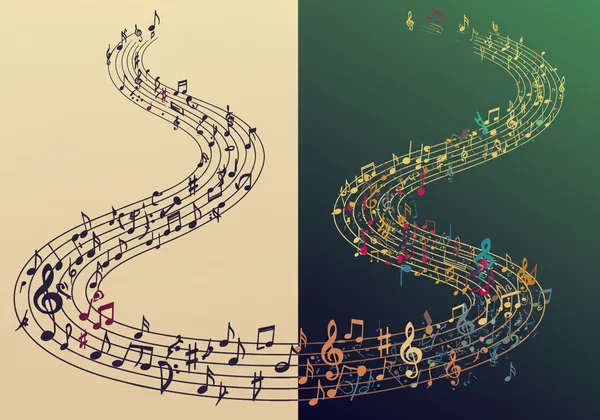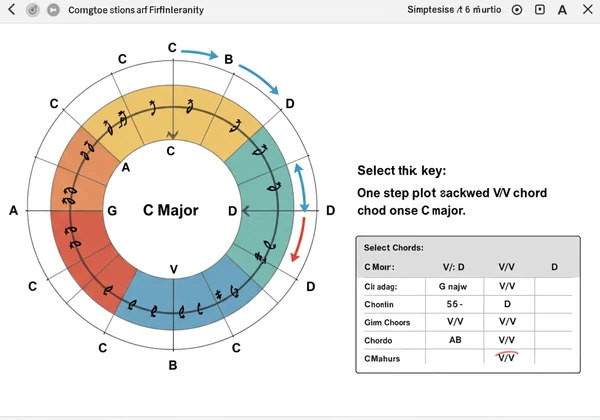Освойте вторичные доминанты: Ключ к композиции в квинтовом круге
Ваши песни звучат слишком предсказуемо? Ваши аккордовые последовательности кажутся застрявшими на избитом пути? Если вы начинающий автор песен, стремящийся отойти от базовых аккордов и придать своей музыке профессиональный блеск, вы открыли для себя один из самых мощных секретов музыкальной теории: вторичные доминантовые аккорды. Но что это за волшебные аккорды, и как вы можете легко найти и использовать их, чтобы преобразить свое написание песен?
Ответ кроется в инструменте, с которым вы, возможно, уже знакомы, но который вот-вот предстанет перед вами в совершенно новом свете. Вторичные доминанты — это ключ к созданию удивительных поворотов, эмоциональной глубины и динамики в вашей музыке. А с помощью интерактивного музыкального инструмента освоить их проще, чем вы когда-либо думали. Давайте вместе раскроем эту важную технику написания песен.

Что такое вторичные доминанты и зачем их использовать?
В любой заданной тональности у вас есть набор "основных" аккордов, известных как диатонические аккорды. Например, в До мажоре это C, Dm, Em, F, G и Am. Хотя эти аккорды являются основой бесчисленных хитов, их исключительное использование иногда может сделать вашу музыку пресной или непрофессиональной. Именно здесь на помощь приходят недиатонические аккорды, чтобы добавить колорита, и вторичные доминанты являются наиболее важным и распространенным их типом.
Вторичная доминанта — это доминанта (или аккорд V ступени) любого диатонического аккорда, кроме тоники (аккорда I ступени). Проще говоря, это аккорд, заимствованный из другой тональности для создания мощного тяготения к одному из ваших диатонических аккордов. Он временно заставляет обычный аккорд ощущаться как новая "опорная точка", добавляя всплеск гармонического колорита и напряжения перед удовлетворительным разрешением.
Понимание доминантовой функции за пределами тональности
Обычный доминантовый аккорд в тональности (аккорд V ступени) имеет одну задачу: создать напряжение, которое стремится разрешиться обратно в тонику (I). Например, в До мажоре аккорд G7 создает мощное притяжение обратно к аккорду До мажор. Это соотношение V-I является краеугольным камнем западной гармонии.
Вторичная доминанта применяет это же мощное соотношение V-I к другим аккордам в тональности. Мы записываем это как "V от..." или "V/..." Например:
- V/V (доминанта от доминанты): Это доминанта доминантового аккорда. В До мажоре доминанта (V) — это G. Доминанта от G — это Ре мажор (или D7). Таким образом, D7 становится вторичной доминантой, которая прекрасно ведет к G.
- V/ii (доминанта от II ступени): В До мажоре аккорд II ступени — это Ре минор. Доминанта от Ре минора — это Ля мажор (или A7). Использование аккорда A7 создает сильное притяжение к аккорду Dm.
- V/vi (доминанта от VI ступени): В До мажоре аккорд VI ступени — это Ля минор. Доминанта от Ля минора — это Ми мажор (или E7). Это одна из самых распространенных вторичных доминант в популярной музыке.
Думайте об этом как о создании мини-разрешений внутри вашей последовательности. Каждая вторичная доминанта действует как указатель, направляя прямо к следующему аккорду и делая путь более захватывающим.

Добавление колорита и напряжения: Звучание профессиональных последовательностей
Итак, зачем использовать эти сторонние аккорды? Потому что они являются секретным ингредиентом, который отделяет пресные последовательности от профессиональных последовательностей. Использование вторичной доминанты вводит ноту, которой нет в исходной тональности (хроматическую ноту), что мгновенно привлекает внимание слушателя.
Эта инъекция музыкального напряжения делает две вещи. Во-первых, она добавляет момент гармонического сюрприза и утонченности. Во-вторых, она создает еще более сильное ощущение разрядки и удовлетворения, когда разрешается в ожидаемый диатонический аккорд. Это разница между прогулкой по прямой дорожке и живописным объездом, который делает прибытие еще более приятным. Эта техника используется повсюду, от The Beatles и Queen до современной поп-музыки, джаза и музыкального театра.
Поиск и применение вторичных доминант с помощью квинтового круга
Вот тут-то теория может показаться ошеломляющей. Как запомнить аккорд V ступени для каждого минорного и мажорного аккорда в каждой тональности? Вам не нужно. Секретное оружие для написания песен с помощью квинтового круга — это использование визуального и интерактивного руководства. Квинтовый круг — это не просто таблица для запоминания ключевых знаков; это карта гармонических отношений.
Наш бесплатный инструмент Квинтового круга делает поиск вторичных доминант невероятно интуитивным. Он превращает абстрактную концепцию в простой, визуальный и слышимый процесс.
Визуализация V/V и других последовательностей на нашем интерактивном инструменте
Давайте вместе найдем V/V в До мажоре. Это так же просто, как два клика:
- Перейдите к интерактивному кругу и убедитесь, что сверху выбрано "C Major". Вы увидите все диатонические аккорды для До мажора.
- Определите доминантовый (V) аккорд, который является Соль мажором.
- На диаграмме Квинтового круга доминанта любой тональности всегда находится на один шаг по часовой стрелке. Найдите G на круге.
- Посмотрите на один шаг по часовой стрелке от G. Вы увидите D.
- Вот оно! Доминанта от G — это D. Ваш аккорд V/V — это аккорд Ре мажор (или, чаще, D7 для дополнительного напряжения).
Теперь вы можете построить последовательность, такую как C -> D7 -> G -> C. Вместо простого движения от C к G вы создали более убедительный и динамичный путь. Вы можете использовать этот точный метод "один шаг по часовой стрелке", чтобы найти любую вторичную доминанту, которая вам нужна.

Распространенные последовательности со вторичными доминантами для авторов песен
Готовы применить это на практике? Вот несколько классических примеров, которые вы можете попробовать прямо сейчас. Перейдите к нашему инструменту, выберите До мажор и следуйте инструкциям, чтобы увидеть, как эти аккорды вписываются в структуру песни.
- "Восходящий ход" к аккорду II ступени (используя V/ii): Очень распространенная последовательность — C -> Am -> Dm -> G. Давайте сделаем ее интереснее. Перед тем как сыграть аккорд Dm, вставьте его доминанту, A7. Новая последовательность: C -> Am -> A7 -> Dm -> G. Аккорд A7 добавляет блюзовый, душевный подъем, который притягивает слушателя прямо к аккорду Dm.
- "Эмоциональный" переход к аккорду VI ступени (используя V/vi): Стандартная грустная или эмоциональная последовательность — C -> G -> Am -> F. Чтобы добавить драматизма, введите доминанту от Am, которая является E7. Новая последовательность становится C -> G -> E7 -> Am -> F. Аккорд E7 делает приход к Am более значимым и искренним.
- "Цепочка доминант": Для по-настоящему сложного, джазового звучания вы можете связать вторичные доминанты вместе. Отличный пример: E7 -> A7 -> D7 -> G7 -> C. Здесь E7 ведет к Ля минору (или A7), A7 ведет к Ре минору (или D7), D7 ведет к G7, а G7 наконец возвращает вас домой к C. Это прекрасный каскад напряжения и разрешения.
Слушайте и учитесь: Использование воспроизведения аккордов для развития слуха
Читать об аккордах — одно, но слышать их — это все. Именно здесь проявляется ключевая особенность нашего инструмента. После того как вы выберете тональность в нашем интерактивном инструменте, вы можете нажать на любой из диатонических аккордов в таблице ниже, чтобы услышать их.
Это обеспечивает мгновенную звуковую обратную связь, что крайне важно для развития слуха. Вы можете построить последовательность в своей голове, нажать на аккорды в нашем инструменте, чтобы услышать, как она звучит, и сразу понять эмоциональное воздействие добавления вторичной доминанты. Почувствуйте разницу между G -> C и D7 -> G -> C. Этот процесс активного слушания научит ваши уши распознавать эти профессиональные звуки, давая вам возможность уверенно использовать их в своей музыке.

Ваш следующий шаг к профессионально звучащим песням
Вторичные доминантовые аккорды — это путь к более продвинутому и выразительному написанию песен. Это инструменты, которые профессионалы используют для добавления колорита, создания напряжения и направления слушателя в увлекательное эмоциональное путешествие. Превращая теорию в практику, вы можете выйти из предсказуемых шаблонов и начать писать музыку, которая действительно выделяется.
Сложность музыкальной теории не должна быть препятствием для вашего творчества. Ключ в наличии правильных ресурсов. Перестаньте пытаться запоминать таблицы и начните исследовать гармонию визуально и на слух. Перейдите к таблице Квинтового круга, выберите тональность и начните свое путешествие. Экспериментируйте, находя "доминанту от..." для каждого аккорда в тональности и слушайте, как происходит волшебство. Ваша следующая великая песня всего в одном клике.
Часто задаваемые вопросы о вторичных доминантах и музыкальной теории
Чем вторичные доминантовые аккорды отличаются от обычных доминантовых аккордов?
Обычный (или первичный) доминантовый аккорд — это аккорд V ступени, который естественным образом встречается в тональности и ведет обратно к тонике (I). Вторичная доминанта — это аккорд V ступени, "заимствованный" из другой тональности, чтобы вести к диатоническому аккорду, отличному от тоники. Например, в До мажоре G7 — это первичная доминанта, ведущая к C. D7 — это вторичная доминанта, ведущая к G.
Могу ли я использовать вторичные доминанты в любой тональности или стиле музыки?
Абсолютно! Хотя они являются отличительной чертой джазовой и классической музыки, вторичные доминанты встречаются практически в каждом жанре, включая поп, рок, кантри и R&B. Они являются фундаментальным инструментом для добавления гармонического интереса, и их применение ограничено только вашей креативностью. Принципы работают одинаково в любой мажорной или минорной тональности.
Как Квинтовый круг упрощает поиск этих аккордов?
Квинтовый круг — это визуальная карта доминантово-тонических отношений. Доминанта любой тональности всегда находится на одну позицию по часовой стрелке на круге. Наш онлайн-инструмент делает это без усилий. Чтобы найти доминанту любого целевого аккорда, просто найдите корень этого аккорда на круге и посмотрите на ноту на один шаг по часовой стрелке. Этот простой визуальный прием исключает догадки и сложные вычисления.
Есть ли другие недиатонические аккорды, которые стоит изучить для написания песен?
Да! Вторичные доминанты являются наиболее распространенным типом, но мир недиатонических аккордов огромен. Другие мощные инструменты включают заимствованные аккорды из параллельного минора (модальное заимствование), уменьшенные септаккорды для добавления напряжения и увеличенные аккорды для мечтательного, неустойчивого звучания. Освоение вторичных доминант в первую очередь обеспечивает прочную основу для изучения этих других красочных гармонических приемов.